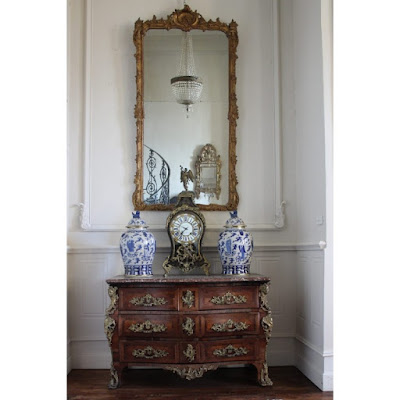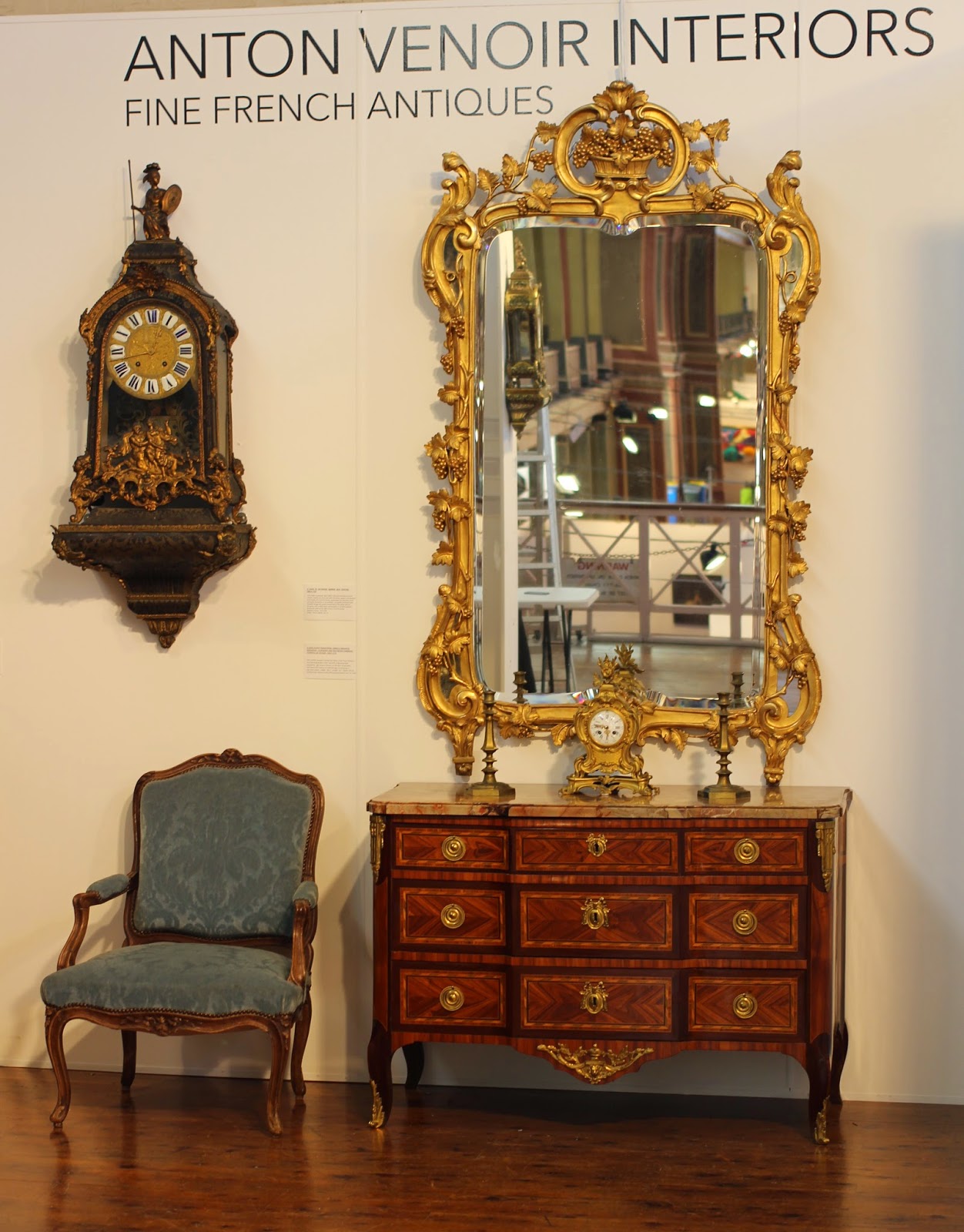AN 18TH CENTURY LOUIS XV ORMOLU MOUNTED KINGWOOD & BOIS DE ROSE COMMODE, BY F.F, JEAN LOUIS FAIZELOT DELORME. CIRCA 1743-1750.
An 18th century Louis XV Ormolu Mounted Kingwood and Bois De Rose, Commode, by Francoise Faizelot, Jean Louis Faizelot Delorme.
CIRCA. 1743 - 1750
The shaped Plateau rouge royal marble top with rounded corners and molded edge above Le cotes galbes facede of, two shaped single draws, with centered secret draw, above a convex long and a further long draw flanked by pierced leaf foliate-cast handles, the angles mounted with pierced foliate espagnolettes and foliate-wrapped bronze ornaments, the whole decorated in Kingwood cross-band marquetry with bois de Rose marquetry borders, centred by a pierced foliate rocaille cartouche, on short conformingly-mounted splayed feet.
Louis XV period, Circa 1743 - 1750. Stamped F.F DELORME, JME. (jurande des menuisiers-ébénistes)
Francois Faizelot Delorme (1691-1768) Maître avant 1735
Jean Louis Faizelot Delorme, Maître 1763
H. 87 cm, L. 130 cm, D. 61 cm.
(b Paris, c. 1715-20; d after 1783). French cabinetmakers and dealers. Were on of the most famous familes of cabinetmakers; father, Francois Faizelot Delorme (1691-1768), and brothers Jean-Louis Faizelot Delorme, Alexis Faizelot Delorme and Adrien Delorme were all maitres-ebenistes. Adrien became a maitre-ebeniste on 22 June 1748 and was a juror of his guild from 1768 to 1770. Jean Louis Faizelot Delorme became maitre ebeniste in 1763. They made and sold luxury furniture throughout the 18th century in the Regence and Louis XV style, decorated with japanning either in imitation of Chinese lacquer (e.g. Amsterdam, Rijksmus.) or with European decoration (e.g. Waddesdon Manor, Bucks, NT). He also carried out sumptuous floral marquetry (e.g. Paris, Petit Pal.). His most distinguished work consisted of small pieces of furniture (e.g. Paris, Louvre; London, V&A; Washington, DC, Hillwood Mus.) embellished with floral marquetry or inlays of scrolls and foliation executed in end-grain wood on a dark-veined, light-wood ground forming a chevron pattern (e.g. Lyon, Mus. B.-A.).
Louis XV Commode tombeau en bois de placage,
XVIIIe siècle elle ouvre par cinq tiroirs sur trois rangs à traverse apparente, les montants galbés, la ceinture à cul de lampe, les pieds galbés.
Ornements de bronze à décor rocaille tels entrées de serrure, poignées, chutes à espagnolette, cul de lampe et sabots. Plateau de marbre rouge royal.
époque Louis XV. Estampille de Jean Louis Faizelot Delorme Maître en 1763 H. 87 cm, L. 130 cm, Pr. 61 cm.
XVIIIe siècle elle ouvre par cinq tiroirs sur trois rangs à traverse apparente, les montants galbés, la ceinture à cul de lampe, les pieds galbés.
Ornements de bronze à décor rocaille tels entrées de serrure, poignées, chutes à espagnolette, cul de lampe et sabots. Plateau de marbre rouge royal.
époque Louis XV. Estampille de Jean Louis Faizelot Delorme Maître en 1763 H. 87 cm, L. 130 cm, Pr. 61 cm.
JME Stamp
On August 20, 1751 the French parliament voted for the constitution of the Jurande.
An additional stamp, JME (for jurande des menuisiers-ébénistes (translation Cabinet Makers & Carpenters)) would be added once a committee, made up of elected guild members who inspected the workshops four times a year, had approved the quality. Any furniture that failed to meet the required standards of craftsmanship was confiscated.
The Corporation des Menuisiers was divided into two distinct trades, that of the woodworkers who made paneling (boiserie) for buildings and coaches, and that of the actual furniture makers. The latter can be subdivided intomenuisiers (joiners), responsible for the making of solid wood furniture such as console tables, beds, and chairs, and the ébénistes, from the word ébéne (ebony), makers of veneered case pieces.
An additional stamp, JME (for jurande des menuisiers-ébénistes (translation Cabinet Makers & Carpenters)) would be added once a committee, made up of elected guild members who inspected the workshops four times a year, had approved the quality. Any furniture that failed to meet the required standards of craftsmanship was confiscated.
The Corporation des Menuisiers was divided into two distinct trades, that of the woodworkers who made paneling (boiserie) for buildings and coaches, and that of the actual furniture makers. The latter can be subdivided intomenuisiers (joiners), responsible for the making of solid wood furniture such as console tables, beds, and chairs, and the ébénistes, from the word ébéne (ebony), makers of veneered case pieces.
The stamp was associated with the guild system that existed at that time. The elaboration of a piece of furniture was a complex process since it involved the collaboration of several artisans, each of which belonged to his own guild, all governed by very strict rules. The executor, who was often the creator, was an ebeniste. The other artisans worked under his supervision, like the sculptor, the engraver, the caster, the gilder, the metal worker, etc.. The cabinet makers’ guild had well defined statutes. The training was the same for everyone. Aspiring master cabinet makers began as apprentices in a workshop where they would stay for several years until they presented their best piece to the “Jurande”. The “Jurande” was a very powerful organ within the guild whose role was to evaluate the candidates to master cabinet makers, as well as the quality of their work. The approved works were stamped with the letters JME (Jurande des Menusiers Ebenistes), a jury of cabinet makers. After 1743 the stamp became obligatory, a rule that was strictly followed in Paris until 1790, when guilds were abolished.
This corporative system fuelled a real “politics of marriages” so that workshops would remain in the family, and resulted in the rise of artisan “dynasties”
This corporative system fuelled a real “politics of marriages” so that workshops would remain in the family, and resulted in the rise of artisan “dynasties”

















































